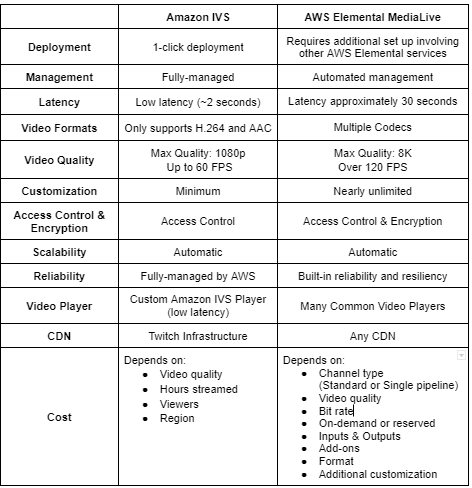Authored by Victor Giubilei, certified senior solution architect and DevOps specialist at TrackIt. The content and opinions in this post are those of the third-party author. AWS is not responsible for the content or accuracy of this post.
A common question the TrackIt team often hears is: “Amazon IVS or AWS Elemental MediaLive – which live streaming solution should we implement?”

Contents
Amazon Interactive Video Service (IVS) & AWS Elemental MediaLive
Amazon IVS
Amazon IVS is a fully-managed and easy-to-set-up AWS live streaming solution that is ideal for creating low latency interactive video experiences. Amazon IVS is built on the same live streaming technology that powers Twitch. It is simple-to-use and can easily be integrated into websites and apps.
Amazon IVS
AWS Elemental MediaLive
AWS Elemental MediaLive is a broadcast-quality live video processing and streaming service offered by AWS. AWS Elemental MediaLive enables users to easily set up live streams with advanced broadcasting capabilities, high-availability, and a wide range of customization possibilities.
AWS Elemental MediaLive
Deployment
Amazon IVS is very easy to set up and deploy. Users simply create a channel, configure their streaming software (i.e. OBS), and start streaming live to their viewers. In contrast, deploying a live streaming pipeline using AWS Elemental MediaLive requires additional setup. Users need to design and assemble the components required for their live streaming pipelines (i.e.create ingest endpoints, connect encoders, select outputs using MediaPackage, and connect outputs to a CDN).
Management
Amazon IVS is a fully-managed solution that helps companies reap the benefits of interactive live streaming without managing the components involved in an associated pipeline.
AWS Elemental MediaLive on the other hand provides automated management. The service transparently provisions resources and manages scaling, failover, monitoring, and the reporting required to power a live video stream. Companies using Elemental MediaLive for their live streams need to manually manage redundancies and properly oversee the lifecycle of resources (i.e. ensure that resources are deployed and removed correctly).
Latency
From a latency standpoint, Amazon IVS has a clear advantage with a latency of around 2 seconds. AWS Elemental MediaLive’s lowest available latency is around 30 seconds, which is typical market performance.
Video Formats, Video Quality, & Video Player
Amazon IVS only supports the H.264 and AAC video formats whereas AWS Elemental MediaLive supports most current codecs. From a video resolution standpoint, Amazon IVS supports a max video quality of 1080p and can go up to 60 FPS. AWS Elemental MediaLive is much more flexible, supporting up to 8K and over 120 FPS. Companies looking to provide 4K and 8K live streaming experiences should consider AWS Elemental MediaLive.
AWS Elemental MediaLive also provides users with the flexibility to choose from a wide selection of video players whereas users choosing Amazon IVS can only benefit from its low latency when they use the custom Amazon IVS Player.
Customization
Amazon IVS offers limited customization possibilities. Users can customize video quality, and incorporate interactive elements in their live streams such as chats, polls, etc. However, users have little control over other elements that go into their live streaming pipeline such as output destinations, CDN choice, format, bit rate, and video formats.
AWS Elemental MediaLive offers a broad range of customization options. Users can customize video quality, multiple output destinations, CDN, add-ons, format choice, encoding settings, and also perform video composition with tools such as image or motion overlays.
The following link provides a summary of the limitations and rules of Elemental MediaLive: https://docs.aws.amazon.com/medialive/latest/ug/eml-limitations-and-rules.html
For more information, consult the AWS Elemental MediaLive Features page: https://docs.aws.amazon.com/medialive/latest/ug/features.html
Access Control & Encryption
Both Amazon IVS and AWS Elemental MediaLive allow users to set up access control for the live streams. However, only AWS Elemental MediaLive allows users to encrypt their streams.
Scalability
Both services are highly-scalable. Companies implementing AWS Elemental MediaLive may need to consider the scalability of the other services they are implementing in their live streaming pipeline.
Reliability
AWS Elemental MediaLive provides built-in reliability and resiliency. The service manages resources across multiple Availability Zones and automatically addresses potential issues without disrupting the live streams.
Amazon IVS is supported by the same infrastructure as Twitch, which has been carefully built for AWS. The simplicity of Amazon IVS implementations could be considered more reliable than custom implementations of AWS Elemental MediaLive.
CDN
Amazon IVS implementations are limited to the Twitch CDN, whereas AWS Elemental MediaLive can choose any CDN and tailor the settings. For example, they can direct traffic, change CDN settings to match video quality settings, and prevent additional costs.
Cost
Amazon IVS and AWS Elemental MediaLive are both cost-effective live streaming solutions. Amazon IVS has a unique pricing model that charges users based on 5 factors: channel type, quality, hours streamed, number of viewers, and delivery region. To get an approximate idea of how much Amazon IVS may cost you, visit https://ivs.rocks/calculator.
AWS Elemental MediaLive uses a straightforward pricing model that charges based on the hours of content processed and delivered. Users should also consider the other services that accompany Elemental MediaLive in order to accurately assess how much live streaming implementation may cost them.
Use Cases
Use Case #1: When Amazon IVS is the better choice
Amazon IVS is the best choice for companies that just want an easy-to-deploy, low latency, out-of-the-box, and cost-effective live streaming solution. An Amazon IVS deployment is quite similar to starting a stream on Twitch, there’s no faster live streaming solution currently available in the marketplace.
Use Case #2: When either of them would work
For companies looking to create a basic web streaming platform that streams the host to multiple clients with no specific requirements regarding speed or latency, both Amazon IVS and AWS Elemental MediaLive would work.
Amazon IVS would be the better choice when a company values a quick deployment, and AWS Elemental MediaLive is better when the company plans on customizing its live streaming pipeline in the future.
Use Case #3: When AWS Elemental MediaLive is the better choice
AWS Elemental MediaLive is the ideal choice for companies who want to have fine control over stream quality, bit rate, encoding parameters, etc. When aggregating the input from multiple sources and switching between them, handling resolutions and video formats not supported by IVS, streaming 4K or 8K, using an Elemental Link box, or encryption requirements, AWS Elemental MediaLive is the better choice.
Plug-and-play streaming with AWS Elemental Link
Use Case #4: When AWS Elemental MediaLive is the cheaper solution
If only a single video resolution is required, AWS Elemental MediaLive can be the less expensive solution. Amazon IVS automatically transcodes to multiple resolutions, and these multiple resolutions count as multiple outputs, incurring additional charges for each output. AWS Elemental MediaLive, however, can be forced to transcode the input stream only to a single resolution to minimize costs.
Conclusion
Amazon IVS is an ideal out-of-the-box live streaming solution for companies looking to effortlessly provide low latency live video streams to their audiences. AWS Elemental MediaLive is an equally attractive live streaming service that becomes particularly relevant when companies are interested in additional customization.
Author Bio

Victor Giubilei is a certified senior solution architect and DevOps specialist at TrackIt. He has master’s degrees in computer science from EPITECH France and the University of Kent with over 4 years of experience in architecting and managing cloud infrastructure for a variety of industries. Victor’s core expertise lies in leveraging AWS’ Elemental suite to build Live streaming and VOD (video-on-demand) solutions for clients.
About TrackIt
TrackIt is an international AWS cloud consulting, systems integration, and software development firm headquartered in Marina del Rey, CA.
We have built our reputation on helping media companies architect and implement cost-effective, reliable, and scalable Media & Entertainment workflows in the cloud. These include streaming and on-demand video solutions, media asset management, and archiving, incorporating the latest AI technology to build bespoke media solutions tailored to customer requirements.
Cloud-native software development is at the foundation of what we do. We specialize in Application Modernization, Containerization, Infrastructure as Code and event-driven serverless architectures by leveraging the latest AWS services. Along with our Managed Services offerings which provide 24/7 cloud infrastructure maintenance and support, we are able to provide complete solutions for the media industry.

